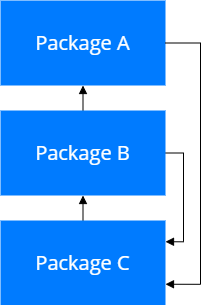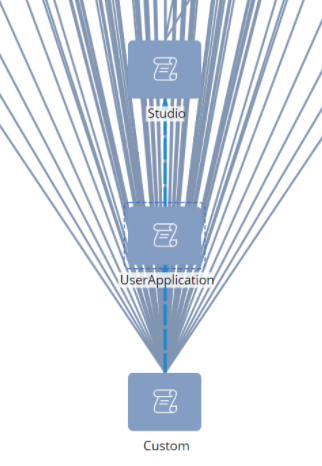Cyclic connection chains in package hierarchy
Since Creatio 8.0 Atlas, Creatio adds the required dependencies automatically for elements created or modified using Freedom UI Designer. I. e., you can use the functionality of all app packages when working with Freedom UI pages, sections, objects, business processes, web services, and schemas. This makes no-code development easy and comfortable for users.
A cyclic dependency is a dependency that occurs when the same package is dependent on the current package and is part of a index of packages on which the current package depends directly or via a dependency chain. Cyclic dependency chains lead to app runtime errors.
Consider an app with A, B, and C packages where the B package depends on the A package, and the C package depends on the B package. Using an element of the C package in the A or B package the C package to be their dependency. Creatio will not execute an operation with such a requirement since it will cause a cyclic chain (Fig. 1).

Using apps that have cyclic dependencies can cause Creatio runtime issues. To avoid this, Creatio checks the app elements used and dependencies configured while saving the app changes. If cyclic dependency chains are detected as part of the check-up, Creatio saves the changes but does not save new package dependencies. You will receive a recommendation to check and fix the dependencies configured. The notification will contain more information about the error as well (Fig. 2):
- Source is a part of the schema that refers to the error-causing element.
- Reference is a name of the element that causes the error.
- Package is a name of the package that contains the element.

We recommend fixing cyclic dependencies before you configure the app further to ensure its operability.
Cyclic chain examples
This section covers several example solutions that cause cyclic chain errors.
If you use an existing schema from the Custom package (Fig. 3) in the "UserApplication" custom app, this will cause a cyclic chain error. Cause: the Custom package depends on every configuration package by default, including the "UserApplication" package. However, the "UserApplication" package must depend on the Custom package to access its elements.

You have created "Application1" and "Application2" apps. If you use "Application1" elements in "Application2," Creatio adds "Application1" to "Application2" as a dependency automatically. If you use the functionality of the "Application2" app in the "Application1" app to improve the latter, this will cause a cyclic chain error.
Prevent cyclic chains
To avoid cyclic chains, we recommend the following:
- If you configure an app using elements from another app, mind the app's resulting dependencies. Transfer both apps into a different environment to ensure the app works as intended.
- Only save the improvements that the app uses to the app package. Make all possible changes in the No-Code Designer of the app. Keep an eye on packages where your changes are saved. If changes are saved to an unintended package, ensure they are moved to the appropriate package in the Configuration section.
Resolve the cyclic chain issue
View examples that resolve the cyclic chain issue in the table below.
Examples that resolve the cyclic chain issue
Way to eliminate cyclic chains | Example |
|---|---|
If you use the wrong elements by mistake, which caused a cyclic chain, you can delete them or replace them with new elements that do not cause a cyclic chain. After that, save the changes to readd the dependencies. | The Read data business process element reads a redundant column or uses it in filtering conditions. To eliminate the cyclic chain, simply delete the column and save the business process. |
If the elements that cause a cyclic chain are not critical to the app operation or you made the changes by mistake, simply revert the changes to eliminate all newly introduced cyclic chains. | You replaced the UsrObject object both in the "UserApplication" app package and the |
If you cannot edit or delete the elements that caused a cyclic chain, move them:
Learn more in a different section: Move the functionality between packages. | A cyclic chain was made when you used the UsrLookup lookup of the |
Do not replace a single object in a single package more than once. If the cyclic chain is caused by two replacements of a single object in two different packages, move the schema that causes the cyclic chain to a third package. The package where you configure the app must inherit from the package to which you moved the schema.